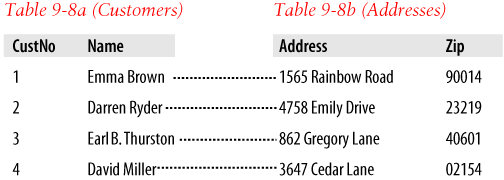Relationships
MySQL is called a relational database management system because its tables store not only data but the relationships among the data. There are three categories of relationships.
One-to-One
A one-to-one relationship is like a (traditional) marriage: each item has a relationship to only one item of the other type. This is surprisingly rare. For instance, an author can write multiple books, a book can have multiple authors, and even an address can be associated with multiple customers. Perhaps the best example in this chapter so far of a one-to-one relationship is the relationship between the name of a state and its two-character abbreviation.
However, for the sake of argument, let’s assume that there can ever be only one customer at any address. In such a case, the Customers-Addresses relationship in Figure 9-1 is a one-to-one relationship: only one customer lives at each address and each address can have only one customer.
Usually, when two items have a one-to-one relationship, you just include them as columns in the same table. There are two reasons for splitting them into separate tables:
You want to be prepared in case the relationship changes later.
The table has a lot of columns and you think that performance or maintenance would be improved by splitting it.

Of course, when you come to build your own databases ...
Get Learning PHP, MySQL, and JavaScript now with the O’Reilly learning platform.
O’Reilly members experience books, live events, courses curated by job role, and more from O’Reilly and nearly 200 top publishers.

